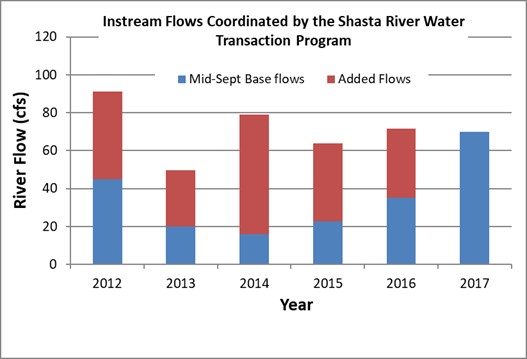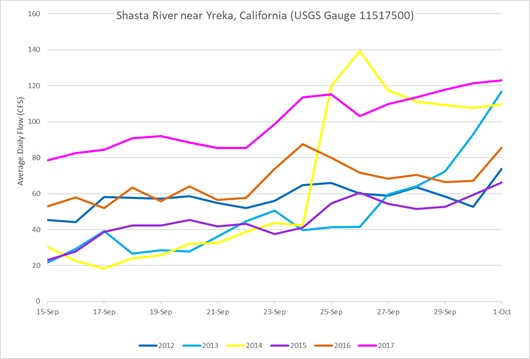Shasta River Water Transaction Program

The agricultural community in Shasta Valley participates in an incentive-based approach to maintaining streamflows to sustain salmon in the Shasta River. © Nancy Crowley

The Water Transaction Program successes from 2012 to 2017. © TNC

Increases in flow as water is voluntarily left instream by the agricultural community to support fish migration flows. © TNC

Shasta River boasts some of highest numbers of Chinook salmon in the Klamath Basin. © Carson Jeffres
Cooperating on Streamflow for Fish and Ranching in Times of Need
The drought has severely limited the availability of water in the Shasta River and its tributaries for salmon. But rather than fighting over water, a consortium of conservation organizations and resource agencies have developed a way to secure water instream, when fish need it most by working in partnership with willing water right holders in the Shasta River Watershed. As a result of these efforts, water is left instream during specific times of the year when flows are limited for for fall Chinook, coho and steelhead. In the face of highly variable precipitation patterns, economic and political disruptions, and climate change, resource managers need tools that allow them to be adaptive and responsive. The status quo in California does not meet these needs, and a new, more dynamic approach to water management is essential. The Nature Conservancy is helping to craft this approach. See the fact sheet: California’s Boom and Bust Cycle, DYNAMICALLY MANAGING RIVERS, ONE HANDSHAKE AT A TIME.
Enough water for this returning Chinook
In the lower Shasta River during the drought, flows were critically low when fall run Chinook salmon returned to the system to spawn. As a result, flows were provided instream during the last two weeks of September to improve water quality and overall volume of water in river’s pools. Instream flow needs assessments recommend a minimum flow in the river at this time of year of 70 cubic feet per second (cfs). In face of the historic drought in California between 30 and 60 cfs of water was provided instream by the ranching community either voluntarily or in the form of short-term lease agreements. On average, this water benefited about 40% of the incoming adult Chinook population who show up in the canyon before the end of irrigation on October 1st. In 2012 given the very large run size, our water transaction benefited over 17,000 adult Chinook that were in the Shasta River canyon.
Market-based Solutions
Water is needed at key times of the year to support the spring outmigration of young coho and Chinook, the fall inmigration of adult Chinook, and to maintain and enhance cold water refugia during the summer for young coho. These times of the year are also critical for irrigation of pastures. The Shasta Water Transaction Program works collaboratively with water users to voluntarily leave water instream or to negotiate short-term agreements that leave water instream for fish. In some cases, water users are compensated at fair market value for the water not used for irrigation. This win-win approach insures that fish water needs are met while making sure our small family ranches stay intact and are sustained for generations to come.
Demonstrating Improvements to Habitat and Water Qualtiy
A study of the relationship between stream flows, habitat capacity, and dissolved oxygen conditions in holding habitat for adult fall-run Chinook in the Shasta River quantified the direct benefit of individual, small-scale flow transactions on ecological conditions. Read Instream Flows: New Tools to Quantify Water Quality Conditions for Returning Adult Chinook Salmon
Water Transaction Program (2012 – 2017)
Since 2012, the Shasta River Water Transaction Program has secured over 6,800 acre-feet of water instream. In 2015 and 2016, over 1,000 acre-feet of water was left instream in each year during the irrigation season to support the adult fall Chinook migration and to build the science around how flows can improve oversummer rearing habitat for coho in the summer. We did not make any water transactions in 2017. Since the water is a valuable resource to the ranchers, we only want to ask for their help when flows are needed instream. 2017 flows in the Shasta River, especially in the fall during the Chinook migration, were over the recommended minimum flow of 70 cfs. Therefore we decided not to enter into any short term agreements with water rights holders.
Project Partners
The Nature Conservancy, Shasta Shasta Valley Agricultural Community, Shasta Valley Resource Conservation District, California Department of Fish and Wildlife, National Oceanographic and Atmospheric Administration, the Scott River and Shasta River Watermaster District, National Fish and Wildlife Federation, and US Bureau of Reclamation.
For more information, contact Amy Campbell, Shasta River Water Transaction Program Coordinator at acampbell@tnc.org.